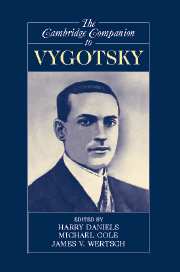Book contents
- Frontmatter
- Editors’ Introduction
- Part I: Vygotsky in Context
- Part II: Readings of Vygotsky
- 6 Terminology in L. S. Vygotsky’s Writings
- 7 Mediation
- 8 Vygotsky and Culture
- 9 Thought and Word: The Approaches of L. S. Vygotsky and G. G. Shpet
- 10 The Development of Children’s Conceptual Relation to the World, with Focus on Concept Formation in Preschool Children's Activity
- 11 Inside and Outside the Zone of Proximal Development: An Ecofunctional Reading of Vygotsky
- Part III: Applications of Vygotsky’s Work
- References
- Index
9 - Thought and Word: The Approaches of L. S. Vygotsky and G. G. Shpet
from Part II: - Readings of Vygotsky
Published online by Cambridge University Press: 28 November 2007
- Frontmatter
- Editors’ Introduction
- Part I: Vygotsky in Context
- Part II: Readings of Vygotsky
- 6 Terminology in L. S. Vygotsky’s Writings
- 7 Mediation
- 8 Vygotsky and Culture
- 9 Thought and Word: The Approaches of L. S. Vygotsky and G. G. Shpet
- 10 The Development of Children’s Conceptual Relation to the World, with Focus on Concept Formation in Preschool Children's Activity
- 11 Inside and Outside the Zone of Proximal Development: An Ecofunctional Reading of Vygotsky
- Part III: Applications of Vygotsky’s Work
- References
- Index
Summary
These two scholars were more than a little acquainted: Vygotsky was Shpet's student at the Shanyavsky People's University, and he attended Shpet's seminar for two years. At the beginning of the 1920s, Vygotsky started to work at the psychological institute where, as Aleksei N. Leont'ev has noted, Shpet was the most famous professor. At the end of the 1920s, Shpet and Vygotsky both taught at the Pedology Department of the Second Moscow University.
Despite all these connections, there is only one reference to Shpet in Vygotsky's works (in The Psychology of Art), and even this is only in passing. And Shpet's books Phenomenon and Meaning (1914), Aesthetic Fragments (1922), and The Inner Form of Word (1927), in which he discussed thinking and language, thought and word, meaning and sense, and external and inner forms of a word were all published significantly earlier than Vygotsky's Thinking and Speech (1934).
Today, it is hard to guess why Vygotsky and his whole scientific school (Aleksandr R. Luria, A. N. Leont'ev, Aleksandr V. Zaporozhets, and others) ignored Shpet's works. It could have been fear or caution born out of Shpet's style of behavior and writing. This style was characterized by freedom and dignity and the independence of his thought from Marxist-Leninist ideology,which at the time was growing stronger and stronger. The Bolsheviks felt this independence, dismissed Shpet several times from his academic positions, and, in the end, arrested and shot him in 1937.
- Type
- Chapter
- Information
- The Cambridge Companion to Vygotsky , pp. 212 - 245Publisher: Cambridge University PressPrint publication year: 2007
- 16
- Cited by

